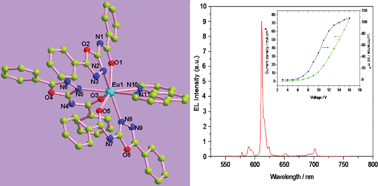Synthesis, structures, photo- and electro-luminescent properties of novel oxadiazole-functionlized europium(iii) benzamide complexes†
Abstract
With N-(5-phenyl-1,3,4-oxadiazol-2-yl)-benzamide (HL1) as the first

* Corresponding authors
a
Department of Chemistry, Zhengzhou University, P. R. of China
E-mail:
dcx@zzu.edu.cn
Fax: +86 371 67763390
Tel: +86 371 67763390
b
College of Materials Science and Chemical Engineering, Tianjin Polytechnic University, Tianjin, P. R. of China
Fax: +86 371 67763390
Tel: +86 371 67763390
With N-(5-phenyl-1,3,4-oxadiazol-2-yl)-benzamide (HL1) as the first

 Please wait while we load your content...
Something went wrong. Try again?
Please wait while we load your content...
Something went wrong. Try again?
F. Zhang, Y. Hou, C. Du and Y. Wu, Dalton Trans., 2009, 7359 DOI: 10.1039/B906470B
To request permission to reproduce material from this article, please go to the Copyright Clearance Center request page.
If you are an author contributing to an RSC publication, you do not need to request permission provided correct acknowledgement is given.
If you are the author of this article, you do not need to request permission to reproduce figures and diagrams provided correct acknowledgement is given. If you want to reproduce the whole article in a third-party publication (excluding your thesis/dissertation for which permission is not required) please go to the Copyright Clearance Center request page.
Read more about how to correctly acknowledge RSC content.
 Fetching data from CrossRef.
Fetching data from CrossRef.
This may take some time to load.
Loading related content
